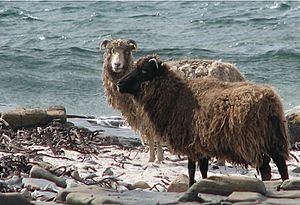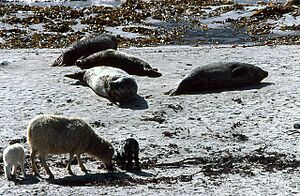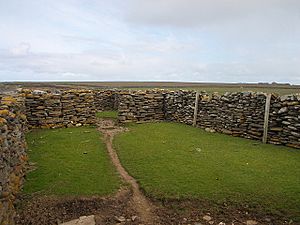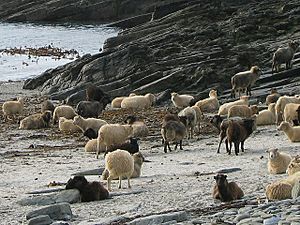North Ronaldsay sheep facts for kids

Two sheep on the shoreline of North Ronaldsay
|
|
| Conservation status |
|
|---|---|
| Country of origin | Scotland |
| Use | meat, wool |
| Traits | |
| Weight |
|
| Height |
|
| Wool colour | white, grey, brown, black |
| Horn status | horned |
|
|
The North Ronaldsay sheep is a special breed of sheep. It comes from North Ronaldsay, a small island in Orkney, off the coast of Scotland. These sheep are part of the Northern European short-tailed sheep family. They have lived on their island for a very long time. This means they haven't mixed much with other sheep breeds.
North Ronaldsay sheep are smaller than most other sheep. Male sheep, called rams, usually have horns. Female sheep, called ewes, are mostly hornless. These sheep were once raised mainly for their wool. Today, the two biggest groups of these sheep live wild, or feral. One group is on North Ronaldsay, and the other is on Auskerry, another Orkney island. The Rare Breeds Survival Trust says these sheep are in danger of extinction. There are fewer than 600 breeding females left in the United Kingdom.
The wild sheep on North Ronaldsay have learned to eat almost only seaweed. They are one of the few mammals in the world that can do this! A huge 1.8 m (6 ft) stone wall goes all the way around the island. This wall keeps the sheep on the beach, forcing them to eat seaweed. The wall was built a long time ago to protect the farmers' fields.
Eating seaweed has changed how these sheep digest food. They are very good at getting a tiny amount of copper from their diet. But this also means they can get sick from too much copper. If they eat grass, which has more copper, it can be harmful to them. Their eating habits have also changed. They eat when the tide is low and the seaweed is uncovered. Then, they rest and digest their food when the tide is high. This helps them avoid getting stuck by the incoming water.
North Ronaldsay sheep have wool in many colors, like grey, brown, and red. Their meat has a strong, unique taste. Some people say it tastes "gamey." This might be because of all the iodine in their seaweed diet.
Contents
The History of North Ronaldsay Sheep
Where Did North Ronaldsay Sheep Come From?
These sheep are related to the ancient Northern European short-tailed sheep. No one knows exactly when they first arrived on North Ronaldsay. It might have been as early as the Iron Age, or even before that! This would make them some of the oldest sheep in Britain. Because they lived on an isolated island, they didn't mix with sheep brought by the Romans or other Europeans. They share some features, like their short tails and many wool colors, with Scandinavian sheep. These sheep were brought by the Vikings when they controlled the islands from the 9th to the 15th centuries.
The Great Wall of North Ronaldsay
In 1832, a huge stone wall was built around the island. This happened after the "kelping" industry failed. Kelping was when people burned seaweed to make soda ash. To help the people who lost their jobs, the land was reorganized. The sheep were then kept away from the farms and fields, called crofts. Since then, the sheep on the island have lived wild on the beach. The wall also helped keep the sheep's unique gene pool pure, stopping them from mixing with other breeds.
This wall goes around the entire coast of the island, about 19 km (12 mi) long. It is 1.8 metres (6 ft) high. It's one of the biggest dry stone walls in the world! In 1999, a group called Historic Scotland said it was a "unique and important structure." They gave it special protection.
Over time, the number of people living on North Ronaldsay has dropped from 500 to about 50. There aren't enough people to fix the wall when it gets damaged. Strong storms, like one in December 2012, have made big holes in it. Fixing the wall costs a lot of money. In 2015, the Orkney Islands Council said that about 4.7 km (3 mi) of the wall needed repairs. More of the wall is getting damaged than is being fixed.
Sheep Punds: Special Enclosures
The punds, or pounds, are nine small walled areas on the island. They are also protected by Historic Scotland. These punds are used to gather the sheep for important tasks. This includes shearing their wool, counting them, helping with lambing (when lambs are born), and preparing them for meat.
The sheep are brought into these punds twice a year. This is the only time they get to eat grass. Between February and August, they come in for lambing and shearing. Lambs are born on the grass from February to May. At this time, the sheep are counted. Lambs get ear tags, and their ownership is recorded by the island's sheep court. Shearing happens in July and August. Everyone on the island helps to gather and shear the sheep. Sheep are only prepared for meat in winter. This is when they are fatter because there is more seaweed available from winter storms.
The North Ronaldsay Sheep Court
The North Ronaldsay Sheep Court was created in 1839, soon after the wall was built. It was a group of eleven islanders. They were in charge of keeping the wall in good shape, making sure the sheep were healthy, and keeping records of who owned which sheep. Today, the Sheep Court still manages the sheep on the island.
Protecting These Unique Sheep
Several groups are working to save the North Ronaldsay sheep. The North Ronaldsay Sheep Fellowship keeps the flock book, which started in 1974. This book lists all the purebred animals. It shows that there are fewer than 600 breeding females and about 3700 sheep in total. The Rare Breeds Survival Trust (RBST) calls the North Ronaldsay sheep "vulnerable."
Other groups on the island include The North Ronaldsay Trust and the Orkney Sheep Foundation. They hold an annual Sheep Festival (SheepFest). During this festival, volunteers come to the island for two weeks to help rebuild the sheep wall.
There are only two main groups of these sheep left. The biggest group is on North Ronaldsay itself. The other group is on the island of Auskerry. This group was started in 1983 by Teresa Probert and Simon Brogan.
Characteristics of North Ronaldsay Sheep
Physical Features
North Ronaldsay sheep are very small. This helps them survive in their cold, harsh environment. Rams usually weigh about 30 kg (65 lb). Ewes rarely weigh more than 25 kg (55 lb). Both stand about 41 cm (16 in) tall at their shoulders. These sheep grow slowly. A full-grown sheep might only provide about 13.6 kilograms (30 lb) of meat.
These sheep are descendants of a very old type of European sheep. As their name suggests, they have naturally short tails. Their bones are thinner than other sheep breeds. Their heads are also slightly dished, meaning they curve inwards. All rams have horns. These horns are usually ridged and spiral-shaped. Only about 20 percent of the ewes have horns; the rest are hornless.
Their Unique Seaweed Diet
North Ronaldsay sheep have a very unusual diet. They eat almost only seaweed! This happened because they live on the shoreline, kept there by the 1.8 m (6 ft) stone wall. This leaves them with only seaweed to eat. Besides the marine iguana from the Galapagos Islands, these sheep are the only land animals known to eat mostly seaweed. Studies have shown that they prefer and mostly eat brown kelps. This discovery has even led people to think that kelp could be a food source for other farm animals.
The sheep's eating habits have also changed to fit their diet. Most sheep eat during the day and digest their food at night. But North Ronaldsay sheep eat when the tide goes out and uncovers the shore. This happens twice a day. They then digest their food when the tide is high. They start eating about 3.5 hours after high tide, when the seaweed is exposed. They stop eating about four hours later, just after low tide. Then they start digesting. This cycle helps them avoid getting trapped by the incoming tide.
In spring, mother ewes are sometimes moved to grassy areas for lambing. They are only returned to the beach around August. Other sheep, like males and non-pregnant females, stay on the beach and eat seaweed all year. Unlike other sheep, North Ronaldsay sheep get fatter in winter. This is because storms throw more kelp and seaweed onto the shore, so there's plenty of food.
These sheep get fresh water from the few freshwater ponds along the seashore. This has made them very good at handling salt. Their diet is full of salt, and fresh water is limited. They can handle the salt in sea salt much better than other sheep breeds. Scientists found this out in a 1997 study. However, they are still trying to understand exactly how the sheep's bodies do this.
How North Ronaldsay Sheep Are Used
Their Meat
When the United Kingdom was part of the European Union, meat from these sheep could be sold as "Orkney Lamb." This meant it had a special protected status. The meat has a unique, rich taste. It's been described as "intense and almost gamey." It also has a darker color than most lamb. This is partly because of the iodine-rich seaweed they eat.
Their Wool
Even though they are small, North Ronaldsay sheep were historically raised for their wool. Their wool comes in many colors and is very similar to the Shetland breed's wool. This is because they share a common ancestor. Common colors are white and grey. But you can also find browns, beiges, reds (called tanay), and blacks. A full fleece weighs about 1 kg (2 lb).
The North Ronaldsay is a "double-coated" breed. This means they have two layers of wool. The undercoat is finer and soft. It's good for clothes that touch your skin. The overcoat is coarser with long hairs. This layer protects the sheep from the cold, wet weather. This tougher fiber is often used for outer garments.
See also
 In Spanish: Oveja de North Ronaldsay para niños
In Spanish: Oveja de North Ronaldsay para niños





